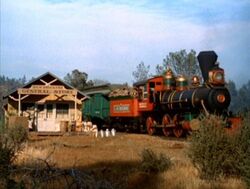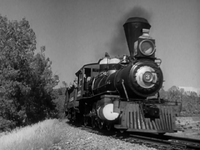
The Hooterville Cannonball

The Hooterville Cannonball is a little old 4-6-0 Ten-Wheeler type steam locomotive run by Floyd Smoot and Charley Pratt. It is the pride, joy, heart and soul of Hooterville, and it is responsible for ensuring the economic and social stability of the town, by helping not only with escorting residents to their destinations, but by also delivering valuable goods, bringing customers and tourists to Hooterville and securing the stable trade between Hooterville and Pixley (and presumably Crabwell Corners as well). Without it, the town would suffer heavily. The train itself is the property of the C.&F.W. Railroad and it is begrudgingly overseen by the uncaring vice president of the railroad, Homer Bedloe who will stop at nothing to put an end to it and its unprofitable existence for his company.
Trivia[]
- In Return to Green Acres, no sign of the Cannonball is seen and the train tracks are nowhere in sight when Sam Drucker's store is shown, making one wonder if either the tracks were moved or something became of the dear old Cannonball.
- The Cannonball locomotive was portrayed in most scenes by Sierra Railway #3, a Rogers 4-6-0 Ten-Wheeler steam locomotive that has appeared in over 200 films and TV shows and is officially the most photographed locomotive in the world. It is also one of very few pre-1900 steam locomotives that is still operational.
- In some close-up shots, instead of Sierra #3, a full-size wooden model was used. The model, which was originally built for the 1950 film A Ticket to Tomahawk, was actually based on a different locomotive, Rio Grande Southern #20. In A Ticket to Tomahawk, RGS #20 (and the wooden model) portrayed the fictional locomotive "Emma Sweeny". The model was repainted for Petticoat Junction, but after the show ended, was returned to its original "Emma Sweeny" paint scheme and put on display in Jackson, California. The wooden model can easily be distinguished on screen from Sierra #3 because the model (like RGS #20) has evenly spaced driving wheels, while Sierra #3 has a large gap between the second and third axles. The model is also somewhat smaller than Sierra #3, since RGS #20 was a narrow-gauge locomotive and Sierra #3 is standard gauge.
- According to Homer Bedloe, the Cannonball was built by the Rogers Locomotive Works in 1891. This is actually true of Sierra #3. This accuracy is somewhat unusual - in most of Sierra #3's movie appearances, it portrays locomotives much older than itself. (For example, Back to the Future Part III, in which Sierra #3 portrays Central Pacific #131, is set in 1885, six years before the locomotive was actually built.)
- In the earlier seasons of Petticoat Junction, the Cannonball had the number 3 on its number plate, in later seasons, it carried the number 8. In-universe, the most likely explanation is that the C&FW Railroad gained a new locomotive that also carried the number 3 and the Cannonball was renumbered to 8 to avoid confusion on their locomotive roster. (The actual reason for the change was to allow shots of the train to be flipped left-to-right without the number appearing backwards.)